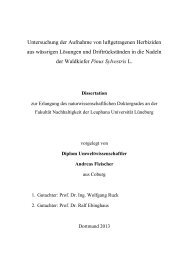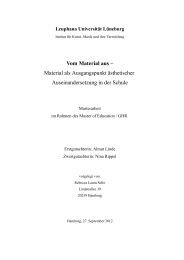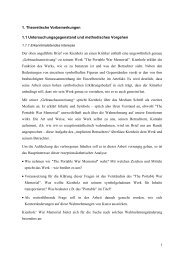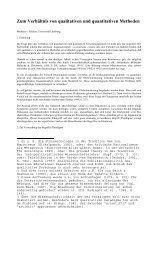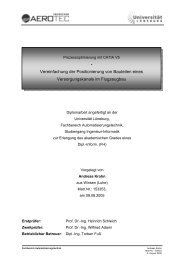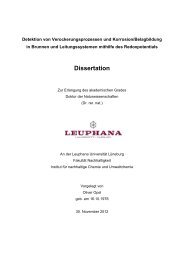Determinants of Emotional Experiences in Traffic Situations ... - OPUS
Determinants of Emotional Experiences in Traffic Situations ... - OPUS
Determinants of Emotional Experiences in Traffic Situations ... - OPUS
Create successful ePaper yourself
Turn your PDF publications into a flip-book with our unique Google optimized e-Paper software.
The <strong>Emotional</strong> Spectrum <strong>in</strong> <strong>Traffic</strong> <strong>Situations</strong> 39<br />
2.2.3 Results<br />
On a scale from one to five the participants liked driv<strong>in</strong>g very much (M = 4.07; SD = 0.99) and rated<br />
its importance with M = 3.37 (SD = 1.28). Cronbach’s-Alpha <strong>of</strong> α = .60 and a correlation <strong>of</strong> r = .44, (p<br />
< .001) revealed a sufficient identity between the two tested aspects <strong>of</strong> driv<strong>in</strong>g motivation. Therefore,<br />
the rat<strong>in</strong>gs <strong>of</strong> the two items (how much one enjoys driv<strong>in</strong>g and how important it is) were comb<strong>in</strong>ed<br />
<strong>in</strong>to one score and labelled as driv<strong>in</strong>g motivation.<br />
2.2.3.1 Occurrence <strong>of</strong> Reported Emotions and Their Relationship to Personal Characteristics<br />
From the sixteen emotions described by the GEW, seven were suitable for this study. To be selected,<br />
the emotion had to appear at least twice dur<strong>in</strong>g the course <strong>of</strong> the experiment across all participants.<br />
Emotions such as disgust or envy were practically never triggered by the given stimulus and therefore<br />
excluded from further analysis (Table 3). The seven emotions that were used were anger, relief,<br />
anxiety, surprise, satisfaction, hope and contempt. Anger was the most prevalent emotion over all<br />
participants with M = 3.12 (SD = 0.55) <strong>in</strong> strength and M = 9.16 (SD = 3.12) <strong>in</strong> frequency <strong>in</strong> the<br />
sixteen situations. Contempt was the weakest (M = 2.14, SD = 1.11) and rarest emotion (M = 2.03, SD<br />
= 2.14) used <strong>in</strong> the more thorough analysis. The emotions anger (H1, H4), anxiety (H2, H4), relief,<br />
hope and satisfaction (H3, H4) as well as contempt (H4) were used to test the hypotheses. Surprise<br />
was an emotion that could not be associated with any hypothesis and was therefore not <strong>in</strong>volved <strong>in</strong> this<br />
process.<br />
The <strong>in</strong>fluence <strong>of</strong> gender, annual mileage and driv<strong>in</strong>g motivation as well as the DAS and STAI<br />
scores (if appropriate) on reported emotion was measured with multiple l<strong>in</strong>ear regressions (Table 4).<br />
Personal characteristics were the <strong>in</strong>dependent variables and the <strong>in</strong>tensities <strong>of</strong> the specific emotions<br />
were the dependent variables. L<strong>in</strong>ear regression made it possible to take any relationships between the<br />
<strong>in</strong>fluenc<strong>in</strong>g attributes <strong>of</strong> the person <strong>in</strong>to account, and this could lead to more precise estimates <strong>of</strong> each<br />
<strong>in</strong>dependent variable (the results are presented as standardized coefficients (β) to facilitate<br />
comparisons). Women reported more <strong>in</strong>tense anxiety and relief than men (β = -.18; p < .048 and<br />
β = -.33; p < .001). Driv<strong>in</strong>g experience was negatively related to anger, and participants with low<br />
mileage reported higher levels <strong>of</strong> this emotion (β = -.25; p < .020). Participants with high driv<strong>in</strong>g<br />
motivation stated more <strong>in</strong>tense anger (β = .22; p < .029) and contempt (β = .21; p < .037) but also<br />
more satisfaction (β = .29; p < .008) as compared to low-motivated drivers. Participants scor<strong>in</strong>g high<br />
on the DAS reported stronger anger (β = .27; p < .001) and contempt (β = .31; p < .001) over the<br />
course <strong>of</strong> the experiment. High trait anxiety participants, as measured with the STAI, reported more<br />
<strong>in</strong>tense anxiety (β = .40; p < .001).<br />
!



